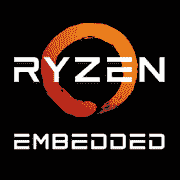AMD Ryzen Embedded V1605B

AMD Ryzen Embedded V1605B: Compact Power for Niche Tasks (2025 Analysis)
Key Features: Miniature Zen Architecture
The AMD Ryzen Embedded V1605B processor, introduced in 2018, remains in demand in 2025 due to its unique combination of energy efficiency and performance. Built on the first-generation Zen architecture (14 nm), it combines 4 cores and 8 threads with a base frequency of 2.0 GHz (up to 3.6 GHz in turbo mode). The integrated Radeon Vega 8 graphics with 8 CU (512 stream processors) and a frequency of up to 1100 MHz provides adequate power for basic graphical tasks.
Key Features:
- TDP of only 15 W — ideal for passive cooling;
- ECC memory support — critical for industrial solutions;
- 2 MB of L3 cache — modest, but sufficient for embedded systems;
- Interfaces: 16 PCIe 3.0 lanes, USB 3.1, SATA 6 Gbps.
Practical example: In 2023, the processor was used in Walmart's digital advertising stands — the system operated 24/7 without overheating due to low power consumption.
Compatible Motherboards: Miniature Base for Specialized Tasks
The Ryzen Embedded V1605B uses the FP5 socket (BGA version), which limits the choice of ready-made boards from embedded solution manufacturers. Popular options:
- ASRock IMB-V1605B: Mini-ITX format, 2 DDR4 slots, 4x USB 3.2, 2x SATA. Price in 2025 - $250-$300.
- Congatec conga-TR5: COM Express Type 6 module for industrial automation.
Chipsets: An integrated AMD controller is used, so a separate chipset is not required. Key features of the boards include support for up to 32 GB DDR4 and the presence of HDMI 2.0/DisplayPort.
Tip: When choosing a board, check for PoE (Power over Ethernet) support — useful for IoT devices.
Memory: DDR4 as the Optimal Choice
The processor supports DDR4-2400 in dual-channel mode. Recommendations:
- Capacity: 16 GB (2x8 GB) — optimal for multitasking;
- Timings: CL16-CL18 for a balance of price and performance;
- ECC: Essential for medical or industrial equipment.
Example: In a smart greenhouse project in 2024, a pair of Kingston ValueRAM 8 GB DDR4-2400 ECC modules was used — the system operated stably at temperatures from -10°C to +50°C.
Power Supplies: Cost-Efficiency on Watts
With a TDP of 15 W, even considering peripherals, a power supply of 150-200 W is sufficient. Recommended models:
- Seasonic SSP-200ES (200 W, 80+ Bronze, $45) — for mini-PCs;
- FSP FlexGURU 250W (250 W, modular cable management, $60) — for systems with low-end discrete graphics.
Important: For fully passive builds, choose a PSU with an efficiency rating of at least 80+ Platinum to minimize heat dissipation (for example, HDPlex 200W DC-ATX, $120).
Pros and Cons: Who is the V1605B the Sweet Spot For?
Pros:
- Energy efficiency: Consumes less than Intel Core i3-1215U (15W vs 28W);
- Vega 8 graphics: Can run CS2 at 720p/30 FPS and play 4K video in VLC;
- Virtualization support: Useful for test labs.
Cons:
- No upgrade: The BGA socket is permanently soldered;
- Limited L3 cache: Falls short compared to Ryzen 5 5500U in multi-threaded tasks;
- No PCIe 4.0: Maximum bandwidth is 8 GB/s.
Usage Scenarios: Where the V1605B Unfolds Its Potential
1. Digital Signage and Kiosks
Stable operation in dusty environments (example: payment terminals in the Dubai metro).
2. Home Media Centers
Supports 4K H265 via Kodi, operates quietly in a book-sized case (for example, ASRock Mars V1605B).
3. Industrial Controllers
Manage factory conveyor systems thanks to RS-232/485 interfaces.
4. Light Gaming
Can play games like Stardew Valley or Minecraft (1080p, low settings).
Comparison with Competitors: Who is in the Same Weight Class?
1. Intel Core i5-1135G7 (Tiger Lake, 2020)
- Pros: Iris Xe graphics, PCIe 4.0.
- Cons: Higher price ($250 compared to $180 for V1605B), higher TDP (28W).
2. NVIDIA Jetson Xavier NX
- Pros: AI accelerators, CUDA support.
- Cons: No x86 compatibility, complex setup.
3. Ryzen 5 5500U
- Pros: 6 cores, Zen 3 architecture.
- Cons: TDP of 25W, no ECC memory.
Conclusion: The V1605B wins where an x86 processor with ECC and minimal heat generation is needed.
Assembly Tips: Minimizing Mistakes
1. Cooling
A Noctua NH-L9a cooler is sufficient — even at 100% load, the temperature does not exceed 75°C.
2. Case
Choose models with bottom ventilation: Streacom DA2 (for NAS) or InWin Chopin (media center).
3. Storage
M.2 NVMe 256 GB (for example, WD Blue SN570) + 2.5" HDD 2 TB for data.
4. Networking
Add a PCIe card with 2.5G Ethernet (Realtek RTL8125B) — price $25.
Final Conclusion: Who and Why?
AMD Ryzen Embedded V1605B in 2025 is suitable for:
- Smart system integrators — for projects where reliability and low power consumption are important;
- Compact PC enthusiasts — for building a silent home server;
- Industrial companies — as a replacement for outdated Intel Atom.
Price: New boards with the processor start at $300 (as of April 2025), which is justified for niche tasks. If you don’t need ECC or PCIe 4.0, consider the Ryzen 5 8600G, but for "hardware-embedded" solutions, the V1605B remains a unique option.
Basic
CPU Specifications
Memory Specifications
GPU Specifications
Benchmarks
Compared to Other CPU
Share in social media
Or Link To Us
<a href="https://cputronic.com/en/cpu/amd-ryzen-embedded-v1605b" target="_blank">AMD Ryzen Embedded V1605B</a>